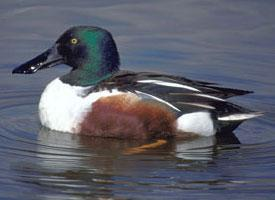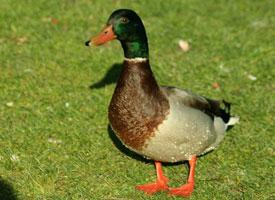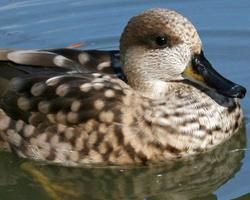
Description de l'animal
The Northern Shoveler (Spatula clypeata), a distinct and visually striking species of dabbling duck, is celebrated for its unique bill shape from which it derives its name. This medium-sized waterfowl presents a fascinating blend of colors and behaviors that captivate birdwatchers and nature enthusiasts worldwide.Physical Description:
The most notable feature of the Northern Shoveler is its large, spoon-shaped bill, which sets it apart from other duck species. This specialized bill is equipped with over a hundred fine projections called lamellae, functioning as a highly effective filtering apparatus. The male, or drake, showcases a striking plumage during the breeding season; a deep green head, white chest, and chestnut sides, complemented by a black bill. In contrast, its wings are marked with a prominent blue patch, known as a speculum, bordered by white. The female shoveler is more subdued in color, with mottled brown feathers that offer excellent camouflage among marsh vegetation, yet she shares the same distinctive bill and wing pattern as the male.
Size and Shape:
Northern Shovelers are medium-sized ducks, with adults typically measuring between 44 to 52 centimeters in length and boasting a wingspan of approximately 76 to 84 centimeters. Their bodies are relatively compact, with large heads and notably long, wide bills that taper to a rounded tip, giving them an almost comical appearance.
Habitat and Distribution:
This species exhibits a broad geographical range, breeding in the northern regions of Europe, Asia, and North America. Their preferred habitats are shallow wetlands rich in aquatic vegetation, including marshes, lakes, and ponds. During the winter months, Northern Shovelers migrate southward to warmer climates, where they can be found in coastal lagoons, estuaries, and occasionally agricultural fields that have been flooded.
Feeding Behavior:
Northern Shovelers are surface feeders, employing their specialized bills to sift through water for food. They engage in a unique feeding behavior known as "shoveling," wherein they swim forward with their bills submerged, filtering out plankton, seeds, and small invertebrates. This method of feeding does not disturb the water significantly, allowing these ducks to feed in the company of other waterfowl without competition.
Reproduction:
The breeding season sees male shovelers engaging in elaborate courtship displays to attract females. Once paired, the couple selects a nesting site on the ground, hidden among tall grasses or reeds. The female lays a clutch of 9 to 12 eggs, which she incubates for about three to four weeks. The ducklings are precocial, meaning they are born with their eyes open and are covered in down, ready to leave the nest shortly after hatching.
Conservation Status:
Currently, the Northern Shoveler is classified as Least Concern by the International Union for Conservation of Nature (IUCN), indicating that it does not face any immediate threats of extinction. However, like many wetland-dependent species, it is vulnerable to habitat loss and degradation, as well as pollution and climate change. Conservation efforts aimed at preserving wetland habitats are crucial for ensuring the continued survival of this unique and fascinating species.
In summary, the Northern Shoveler, with its distinctive bill and colorful plumage, is a remarkable example of avian adaptation and beauty. Its presence enriches the biodiversity of wetlands across the globe, making it a species of interest not only for ornithologists but for anyone with an appreciation for the natural world.
Carte de répartition
Animaux similaires
Nouvelles photos d'animaux
Top 10 des animaux
- Dolphin gull (Leucophaeus scoresbii)
- Diana monkey (Cercopithecus diana)
- Moustached guenon (Cercopithecus cephus)
- Galápagos tortoise (Geochelone nigra complex)
- Japanese macaque (Macaca fuscata)
- Russian tortoise (Testudo horsfieldii)
- Stone loach (Barbatula barbatula)
- Greek tortoise (Testudo graeca)
- Common flying dragon (Draco volans)
- Vendace (Coregonus albula)


